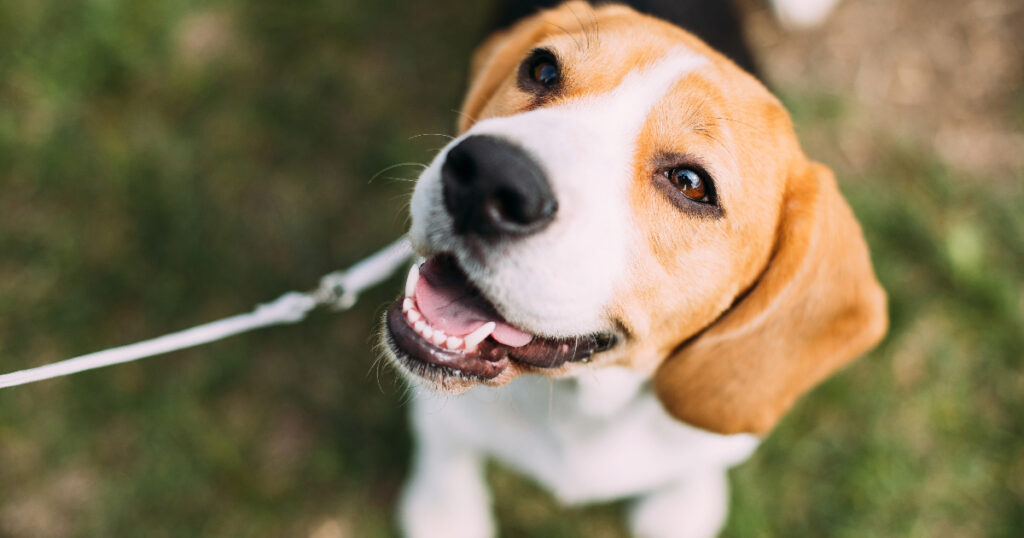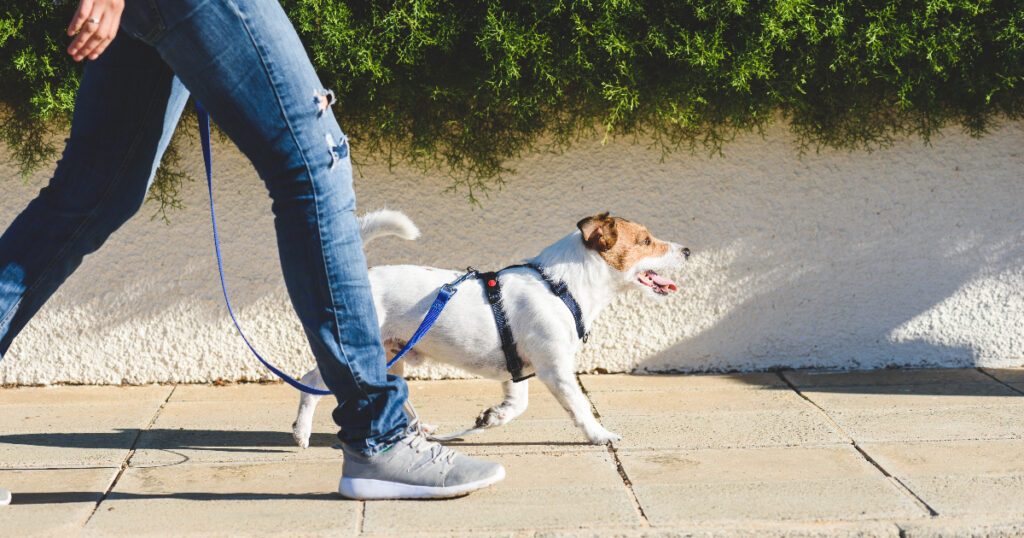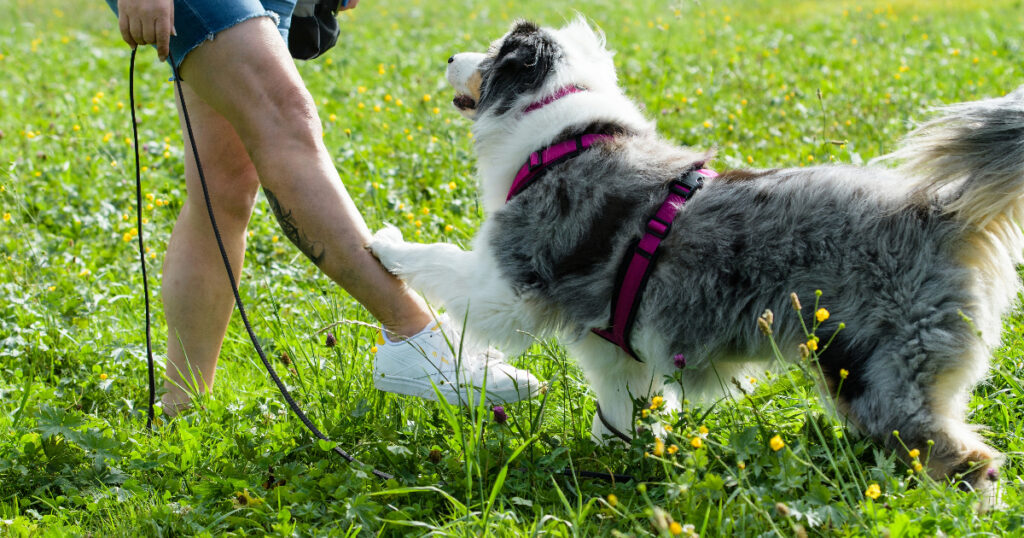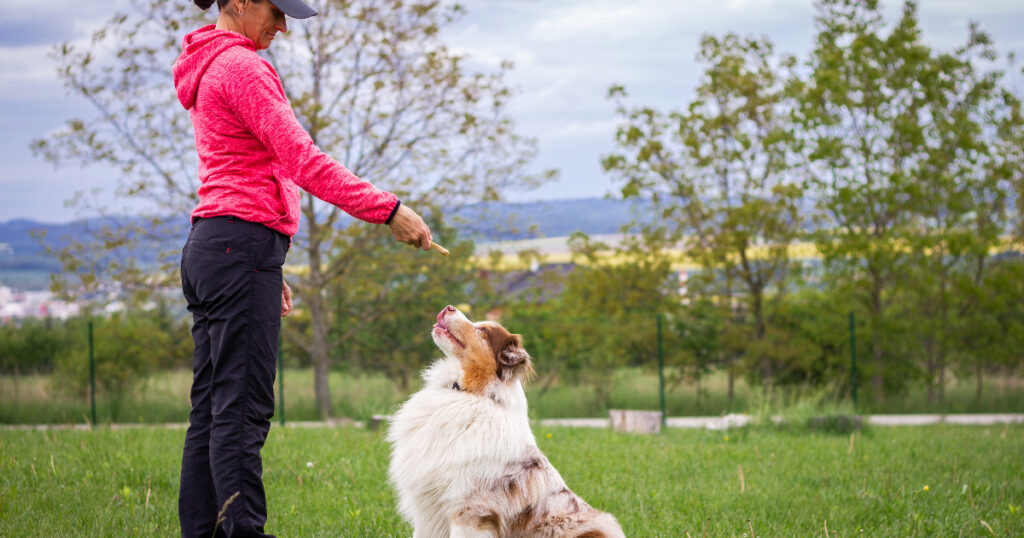Taking your beloved older dog for walks is one of life’s great pleasures. But the experience can quickly turn frustrating if your mature pup pulls relentlessly on the leash and ignores your cues. While leash manners may have never been taught or have eroded over time, it’s never too late to train your senior dog. With patience, consistency, and the use of positive reinforcement, your dog can learn to walk politely on a leash – even in their golden years. This article provides techniques tailored for the older dog to master leash skills for calmer, more relaxing strolls. We’ll cover everything from gathering the right training tools to reading your dog’s body language for signs of stress. With the proper guidance, your mature mutt can indeed learn this new trick.
Gather the Right Supplies for Leash Training an Older Dog
Before you start leash training your older dog, you’ll need to gather the proper supplies. Having the right equipment will make the training process go much smoother. Here are some of the essentials you’ll want to have on hand:
Training collar and leash. Use a short 4-6 foot leash specifically designed for training. This allows you to keep your dog close so you can quickly correct unwanted behavior. A training collar like a martingale or front-clip harness gives you added control.
Treats. Bring along highly motivating treats like small pieces of chicken, cheese, or hot dogs. You’ll use these to reward your dog for good leash manners.
Water. Have water on hand so you can give your dog a drink during training sessions. This is especially important on hot days.
Proper identification. Make sure your dog is wearing a collar or harness with current ID tags. This is a safety precaution in case he manages to slip out of his leash.
Having the right gear will make it easier to get your older dog’s attention, provide proper motivation through treats, and keep him safe.
Get Your Dog Comfortable With the Leash and Collar

Before you head out for leash training, your dog needs to be completely comfortable wearing his collar and leash. Take the time to let him get used to the feel of these new accessories:
Desensitize slowly. Put your dog’s collar and leash on in the house for short sessions of 5-10 minutes. Pair it with praise, pets, and treats so he associates it with good things.
Let him drag the leash. With the leash attached to his collar, let your dog wander freely indoors while dragging the leash behind him. Supervise him during this time.
Increase wear time. Gradually build up the amount of time he wears the leash and collar in the house before trying outdoor training. The goal is for your dog to barely notice he has them on.
Rushing into leash training before your dog is totally comfortable with his equipment could lead to fear and anxiety. Make sure he’s completely relaxed wearing his walking gear first.
Start Training in a Low Distraction Setting
It’s important to start leash training your older dog in an environment with minimal distractions. Areas with lots of activity and other dogs can be overstimulating. Begin training in a quiet setting:
Train indoors first. Start by doing training sessions inside your home or in your backyard. There are fewer distractions for your dog to focus on.
Gradually add distractions. As your dog masters leash skills indoors, start doing short training sessions outside your home. Slowly increase the environmental stimuli.
Stay focused. When training, focus your dog’s attention on you by using high-value treats. Keep training sessions short so he stays focused.
Watch for stress signals. Look for signs of stress like lip licking, yawning, or shaking off. If your dog seems overwhelmed, decrease the distractions or end the session.
Low-stimulus training areas will set your dog up for success instead of frustration. You can always increase the challenge after he masters the basics.
Teach Loose Leash Walking

One of the main goals of leash training is teaching your dog not to pull on walks. Here are some methods to train loose leash walking:
Use a verbal cue. Say “Let’s go” or “with me” when you want your dog to walk by your side without pulling. Use a happy, upbeat tone.
Stop the movement when he pulls. As soon as your dog starts pulling on the leash, immediately stop walking. Stand still until the leash relaxes. Then continue on your walk.
Change directions. When your dog pulls, turn and briskly walk in the opposite direction. This will reorient him back to you. Praise when he catches up.
Reward good behavior. Give your dog treats whenever he chooses to walk next to you without tugging on the leash. This reinforces the behavior you want.
Use a training aid if needed. Consider using a front-clip harness or head halter to discourage pulling if your dog struggles with this concept.
With consistency and plenty of rewards, your older dog will pick up loose leash skills. This makes walks much more pleasant for both of you.
Practice the “Heel” Cue for Better Control
Teaching your dog the “heel” cue provides you with more control during leash training sessions. Follow these steps:
Start in a low-distraction area. Begin working on healing indoors or in your enclosed yard where your dog can focus solely on you.
Allow slack in the leash. Let your dog walk out in front of you, keeping the leash loose. Don’t force him to your side yet.
Give the cue when he’s aligned. When your dog is correctly positioned next to you, say “heel” in an upbeat tone of voice. Reward him with praise and a treat.
Use leash pressure if needed. If your dog forges ahead, gently pull up and back on the leash when you give the “heel” cue. Don’t jerk harshly.
Vary speed. Practice heeling at different walking speeds – a brisk jog, normal pace, and slow amble. Your dog should stay aligned with you.
Wean off treats slowly. Once your dog understands the heel cue, you can gradually reduce treat rewards as you practice. But continue praising him.
With regular repetition, the “heel” cue becomes ingrained. Your dog will learn to stay aligned without constant food rewards.
Use Positive Reinforcement to Motivate Your Dog

Positive reinforcement should be your main training tool when leash training an older dog. Here’s how to do it right:
Mark correct behavior. Use a clicker or say “Good boy!” the instant your dog performs the behavior you want like loose leash walking.
Reward afterward. Quickly follow up your marker by giving your dog a treat. This connects the reward to the desired action.
Vary rewards. Use different types of treats to keep your dog motivated. Food, toys, and play can all be rewards.
Keep it fun! Training should be an enjoyable experience for you and your dog. Use an animated, happy voice and laugh when your dog gets it right.
Avoid corrections. Never punish your dog for making a mistake. Just ignore the bad behavior and reward the good.
Making training a positive experience will keep your older dog engaged and uncomplicated. He’ll want to work for you!
Use Short, Frequent Training Sessions
When leash training an older dog, keep your training sessions short but do them frequently throughout the day. Here are some tips:
Limit sessions to 5-15 minutes. Older dogs have shorter attention spans. Keep training sessions brief to avoid your dog getting bored or frustrated.
Do two or three sessions daily. Repeating short training sessions allows skills to sink in better through frequent repetition.
End on a high note. Finish up sessions when your dog successfully executes the skill you’re teaching. This keeps him motivated.
Keep it low-key. Avoid high-energy running or playing before a training session. Your dog will focus better when calm.
Watch your dog’s signals. If he seems stressed or tired, stop the session. Pushing him too far can cause negative associations.
Frequent, short training bursts are the key to helping your older dog retain what he learns. Pay attention to his needs during sessions.
Introduce Distractions Gradually
Once your older dog has mastered leash skills at home, he needs practice in more stimulating environments. Expose him to distractions slowly:
Start in low-distraction areas. Begin challenging your dog by training on quiet neighborhood streets with few people or dogs around.
Gradually increase distractions. Over multiple training sessions, practice in areas with more people, dogs, bikes, etc. But go slowly so your dog isn’t overwhelmed.
Stay observant. Keep a close eye on your dog’s body language and reactions to things in the environment. If he seems stressed, move farther away from the distraction.
Stay positive! When your dog remains focused on you around distractions, reward him heavily with excited praise and treats.
Keep sessions short. It will take full concentration for your dog to tune out distractions. Keep training sessions brief – around 10 minutes max.
By incrementally increasing environmental challenges, you set your dog up for success instead of failure.
Use the Right Techniques for a Strong “Come” Cue
A reliable recall or “come” command is important for any dog, but especially one who walks off leash. Follow these tips to train it:
Start indoors – Begin teaching the “come” cue in your house or yard where there are minimal distracting sights and smells.
Use a long line – When training “come” outside, keep your dog on a 20-30 foot training leash so he can’t run off if you call him.
Make it fun – When your dog comes, greet him happily like he’s the most exciting thing in the world. Play with a toy or give treats.
Increase the challenge – Over time, practice “come” in more distracting environments after the cue is solid at home. Go slowly without adding difficulty.
Randomize it – Say “come” when your dog is focused on something interesting. Don’t overuse it or he’ll become desensitized.
Avoid repeating cues – Only say “come” once then gently guide or reel your dog in if needed. Don’t nag him to come.
With regular rewarding practice, your older dog will learn coming to you is worthwhile. A reliable recall keeps him safe.
Watch Your Dog’s Body Language
It’s important to be observant of your dog’s body language and stress signals when leash training:
Look for lip licking or yawning. These are signs your dog may be getting stressed by the training.
Watch the tail. A slowly wagging or tucked tail can signal discomfort or anxiety.
Note the ears. Ears pressed back is often a sign your dog is feeling uneasy about something.
Look for shaking off. If your dog suddenly shakes as if wet, he may be trying to release tension.
Watch the eyes. A dog who averts his gaze and avoids eye contact may be feeling insecure.
See how he carries himself. Low or tucked body posture can indicate nervousness or fear.
If you notice these stress signals, end the training session immediately and try again later in a lower-stimulus environment after your dog relaxes. Paying attention to his body language prevents pushing him beyond his limits. He will learn best when he’s comfortable.
Be Patient and Consistent
The keys to effectively leash training an older dog are simple – be patient and consistent! Here are some tips:
Stick with it – If your dog doesn’t seem to be making progress, don’t give up. Consistency and repetition are crucial.
Keep sessions short – With older dogs, work on training for just 10-15 minutes at a time, several times a day. This prevents boredom.
Stay positive – Remember that the tone and manner in which you teach your dog have a huge impact. Always stay calm and upbeat.
Go at your dog’s pace – Let your individual dog determine how fast or slow to take training. Avoid rushing into environments he’s not ready for yet.
Celebrate small successes – Any step forward for your dog is worthy of celebration. Lavish him with praise and treats for even tiny signs of progress.
Watch for signs of stress – If your dog shows any discomfort, stop immediately and regroup. Forcing him will only instill fear and confusion.
Training an older dog takes time and dedication. But being patient and disciplined in your approach will pay off!
Consult a Trainer If Needed

If you’re still struggling with leash training your older dog after working diligently on it for several weeks, consider contacting a professional dog trainer for help. Some benefits of working with an expert include:
Evaluating your dog – A trainer can observe your dog’s behavior and determine why he may be having difficulties learning.
Private lessons – Many trainers offer private in-home lessons tailored specifically to your dog’s issues and your goals.
Troubleshooting – An experienced trainer can pinpoint what you may be doing wrong and offer corrections to your technique.
Extra guidance – A trainer provides extra guidance and supervision during the training process.
Faster progress – Your dog may learn more quickly with a professional guiding the training.
Confidence building – Having a trainer assisting you can boost your confidence working with your dog.
While every dog can be taught, some benefit from having an expert take the lead. Consider consulting a positive reinforcement trainer for extra help.
Leash training your older dog takes time and repetition, but the investment is well worth it. With the right approach and techniques, you can teach your mature pup some new walking tricks – and enjoy less frustrating, more relaxing strolls together. Just remember to gear the training to your individual dog, keep it positive, reward your dog frequently, watch for signs of stress, and be as patient with yourself as you are with your dog. Consistency and compassion are key when training an older canine companion.
FAQ
What’s the best way to introduce distractions when leash training an older dog?
Go slowly when adding environmental distractions. Start in areas with minimal stimulation like your house or backyard. Gradually move to quiet outdoor locations before exposing your dog to more challenging scenarios with lots of people, dogs, traffic, etc. And when you practice around distractions, try to keep sessions very short – 5-10 minutes maximum. This prevents your dog from becoming overstimulated. You want him focused on you, not everything going on around him.
Should I use a retractable leash for training my older dog?
Retractable leashes are not ideal for initial leash training. They give the dog too much freedom to wander and don’t provide the control you need to teach skills like loose leash walking. Stick with a regular 4-6 foot leash or a slightly longer training lead until your dog has mastered the basics. Once your dog is reliably trained, a retractable leash can be used to provide him more freedom on walks.
My older dog gets really excited when he sees other dogs on our walks. How can I control this?
It’s common for untrained dogs to get extremely excited at the sight of other dogs when out on a leash. Start by only walking your dog in low-distraction areas with few dogs around. When you encounter other dogs, create as much distance as possible and use treats to keep your dog’s focus on you instead of the other dog. If he remains calm, heavily reward him. Practice this frequently until he learns to ignore other dogs on walks.
What type of collar is best for leash training an older dog?
For most older dogs, a front clip harness provides the most control while leash training. The leash attachment on the chest prevents the dog from pulling efficiently. Head halters are another good option. But flat collars with a separate training leash can work too. Avoid choke and prong collars which operate by causing pain and discomfort. Positive methods are best for older dogs.
Conclusion
At the end of the day, successfully leash training your older dog comes down to two key things – patience and consistency. Set realistic expectations, go at your dog’s pace, keep training sessions brief and rewarding, and stick with it.
Pay close attention to your dog’s signals to avoid pushing too far too fast. Your hard work and dedication will pay off with a well-mannered walking companion. And don’t hesitate to enlist the help of an expert trainer if you need some additional guidance.
With the right approach, even senior dogs can learn important new skills to make their walks relaxing rather than rowdy.

